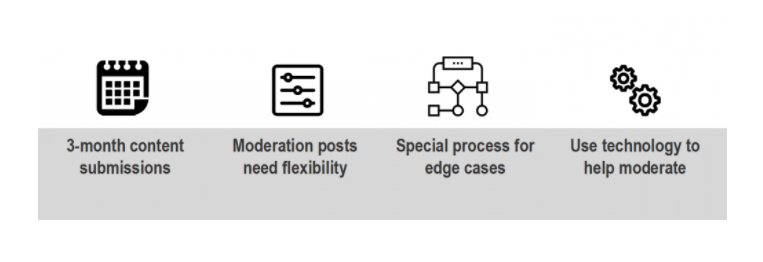Humans have shared stories and information with each other since the dawn of time, but with the advent of social media and smartphones, sharing ideas is easier than ever. People are now online at all hours of the day and are constantly connected to others in their social circles and beyond. As a result, marketers have recognized the value in maintaining a strong presence on these channels to reach customers.
Social media usage is pervasive in the wider marketing community, but it had been adopted more slowly among the B2B crowd, especially in science. With an increasing amount of scientists and scientific companies becoming active on social media, the channel has proven itself as an important method for members of the scientific community to communicate with one another.
However, because the sciences are often carefully regulated to ensure the protection, safety, and health of patients, B2B companies face additional challenges in interacting with their audience online. With the right approaches, companies can still reap the benefits of a social media engagement program without taking on too much risk.
Here are our best 10 tips for remaining compliant.
 1. Learn the rules.
1. Learn the rules.
Everyone at your organization should understand the rules so that no one inadvertently breaks one. Sounds simple enough, but let’s get specific:
While regulations around social are constantly evolving, the two biggest sets of regulations science marketers need to know come from the U.S. Food and Drug Administration (FDA) and the Federal Trade Commission (FTC). FDA provided draft guidance for pharma and social media use back in 2014, but note they still have not issued their final guidelines.
Their recommendations are intended to protect consumers and educate healthcare professionals by presenting important risk and benefit information for prescription drugs and medical devices. In summary, when companies post about a particular drug or device, they must find a way to disclose the benefits and side effects of that product. Otherwise, they could be guilty of misleading consumers with inaccurate or incomplete information.
Even with its expanded character count, Twitter is a particularly challenging platform for providing enough fair balance of benefit/risk information about a drug product. To avoid this, companies may want to avoid naming FDA approved products on social media. A good practice is to direct visitors to disease area or product webpages where they can find complete information. Follow Novartis’ US clinical trials recruitment account here to see the best practice in action.
The FTC, an agency that protects America’s consumers, has its own set of guidelines for transparency in advertising and marketing. They state companies must support their advertising claims with solid proof. These rules are intended to enforce “truth in advertising,” and pertain to any promotional posts about food, over-the-counter drugs, dietary supplements, contact lenses, and other health-related products. Keep this rule in mind and be prepared to substantiate any health claims with validated studies and other evidence.
2. Tread carefully when talking about research.
In addition to exercising caution when talking about products, be very aware of how you talk about scientific research. First, of course, don’t discuss unpublished research on social media. But even talking about published research can be challenging, as many social platforms are intended for short, concise thoughts. As a result, research findings can be misconstrued if the appropriate context is omitted. John Oliver famously ranted on this very issue last year. Brevity is the soul of wit, but when it comes to scientific facts, you can’t afford to cut corners.
Just read this post from Stat for one example.
3. Establish internal corporate guidelines.
Once you have reviewed the regulations, speak to a lawyer: either a consultant or someone from your own legal department. Partner with them closely so you have definitive internal guidelines for what is appropriate to share on social media, and as noted in this Forbes’ article, how to manage comments from patients who want a dialog.
 4. Choose the right platforms for your brand.
4. Choose the right platforms for your brand.
This may not seem like it has anything to do with regulations, but if you don’t know where your audience is, you’re simply going speaking to the wrong people, – and navigating this issue for little return. Take the time to conduct surveys or focus groups to learn which platforms your core audience frequents. Remember to still listen on all the networks even if you’re not actively engaged, as that’s the only way to find and monitor popular discussions in your industry.
5. Think about your goals on social media.
Who is your audience and what content matters to them? If your audience is consumer-based and they want education, then be sure your posts are informative. If your audience is researchers who want to know the latest being published in their field, highlight exciting developments as they occur. The point here is that there is a lot you can say on social media that doesn’t go against FCC or FDA guidance. To see how, take a look at the top 10 pharma companies and how they use their social media channels for patient education and to promote company news.
6. Plan ahead.
Although much of social media management is responding to people on the fly and keeping up with timely, emerging trends, you can still plan weeks and months ahead for a lot of the content you share. Creating a social media calendar helps give your colleagues responsible for legal and corporate review enough time to turn around edits to social posts.

7. Consider the consequences.
Keep in mind that if you engage on social media, it is not completely risk-free. Entrust the log-in information to responsible team members and ensure that they understand the social media guidelines, as well as any consequences that could ensue if they are not followed.
 8. Don’t sound like a robot.
8. Don’t sound like a robot.
Although it may seem there are a lot of limitations, that doesn’t mean your brand can’t have a distinct voice on social media. You can remain compliant with the rules while still injecting personality and warmth into your messaging. The important takeaway here is that this rule of thumb should be a part of your guidelines, too.
Need inspiration for a campaign that does the trick? Highlight your amazing scientists, staff or company initiative.
9. Start small.
If the thought of launching a fully involved social media campaign intimidates you, pick a particular product or disease area to start and build up your social media presence gradually. You’ll learn a lot about navigating regulations as you go.
10. Have the courage to be a pioneer.
Even if your competition isn’t on social media, lead the way. The more companies that get on social, the more we all learn together about using it effectively.
As tempting as it is to avoid the headaches that regulations can cause, social media is an important marketing tactic. As pharma and other heavily regulated industries embrace digital communication channels more and more, the guidelines around them will become more clear. But for now, these tips should help you feel more comfortable being social-savvy.


















